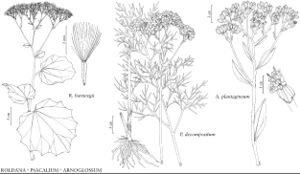Psacalium
in F. Cuvier, Dict. Sci. Nat. ed. 2, 43: 461. 1826.
| Taxon | Illustrator ⠉ | |
|---|---|---|
 | Roldana hartwegii Psacalium decompositum Arnoglossum plantagineum | Yevonn Wilson-Ramsey Yevonn Wilson-Ramsey Yevonn Wilson-Ramsey |
Perennials, [10–] 80–150 [–300] cm (rhizomes usually fleshy; plants hairy or tufted-hairy to unevenly glabrate). Stems single or clustered, erect. Leaves basal and cauline (proximal largest, cauline progressively smaller distally, bractlike); alternate; petiolate (petioles well defined, attached to blades at bases [attached near centers, leaves peltate]); blades palmately or pinnately nerved (and, usually, lobed), mostly ovate to elliptic [orbiculate, polygonal], ultimate margins entire or toothed, faces glabrous or sparsely [densely] hairy. Heads discoid, in corymbiform to paniculiform arrays. Calyculi of 1–3 [–5] bractlets (shorter than [equaling or longer than] phyllaries). Involucres cylindric to weakly turbinate, 1.5–4 [–10+] mm diam. Phyllaries persistent, mostly 5–8 [–17] in 1–2 series, erect, distinct, ovate, obovate, or oblong, subequal, margins scarious (tips greenish or gray to whitish, not black). Receptacles flat, foveolate (sometimes hairy), epaleate. Ray-florets 0. Disc-florets 5–8 [–80], bisexual, fertile; corollas white or ochroleucous [yellow, purplish], tubes longer than the campanulate or ± lacking throats, lobes 5, ascending to spreading, lance-linear; style-branches: stigmatic areas continuous, apices rounded-truncate. Cypselae mostly ± ellipsoid, ± compressed, [10–] 14–18-ribbed, glabrous or hairy; pappi [0] persistent (fragile), of 100–120, white or creamy, barbellulate bristles. x = 30.
Distribution
sw United States, mostly Mexico and Central America
Discussion
Species ca. 42 (1 in the flora).